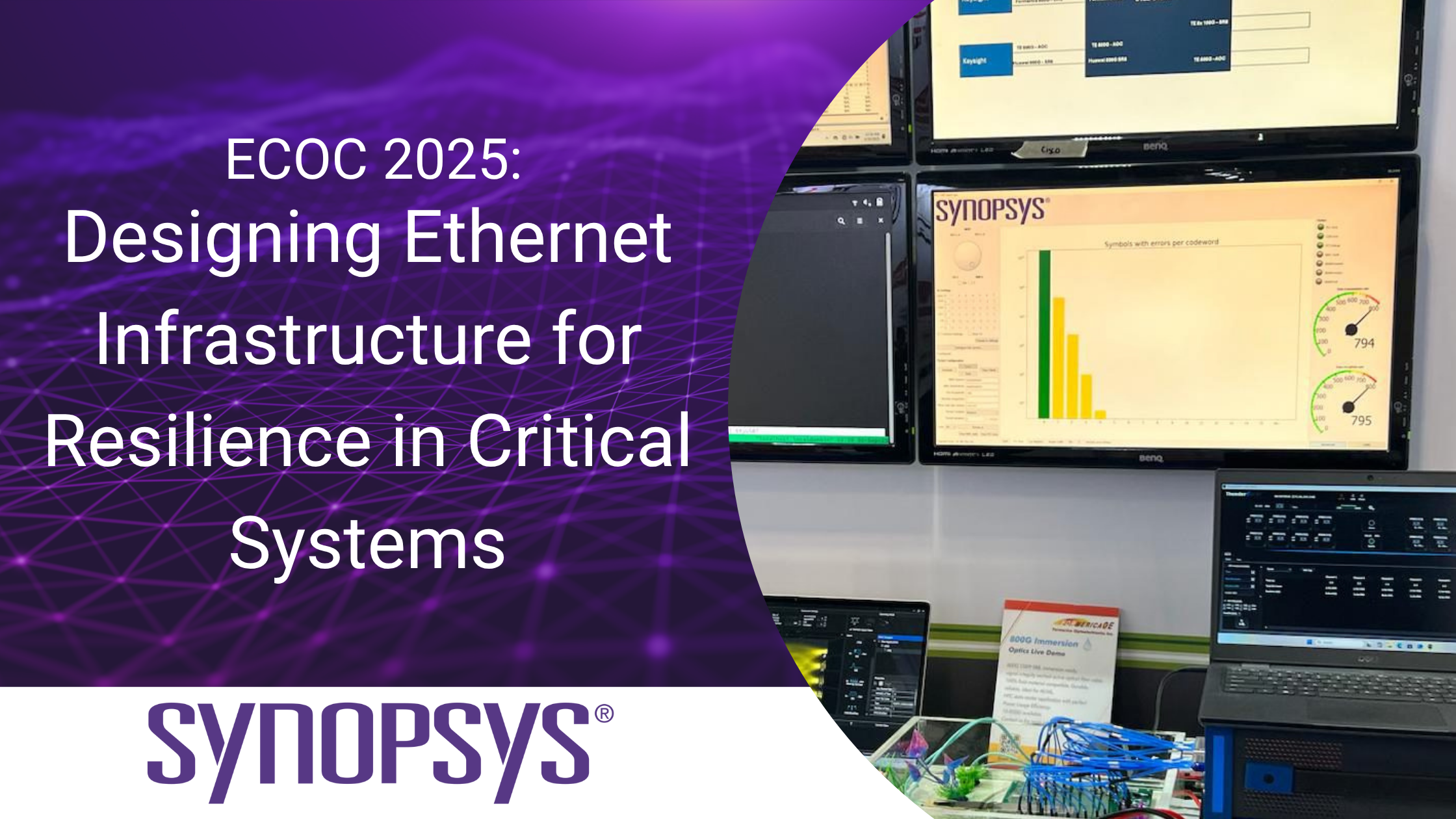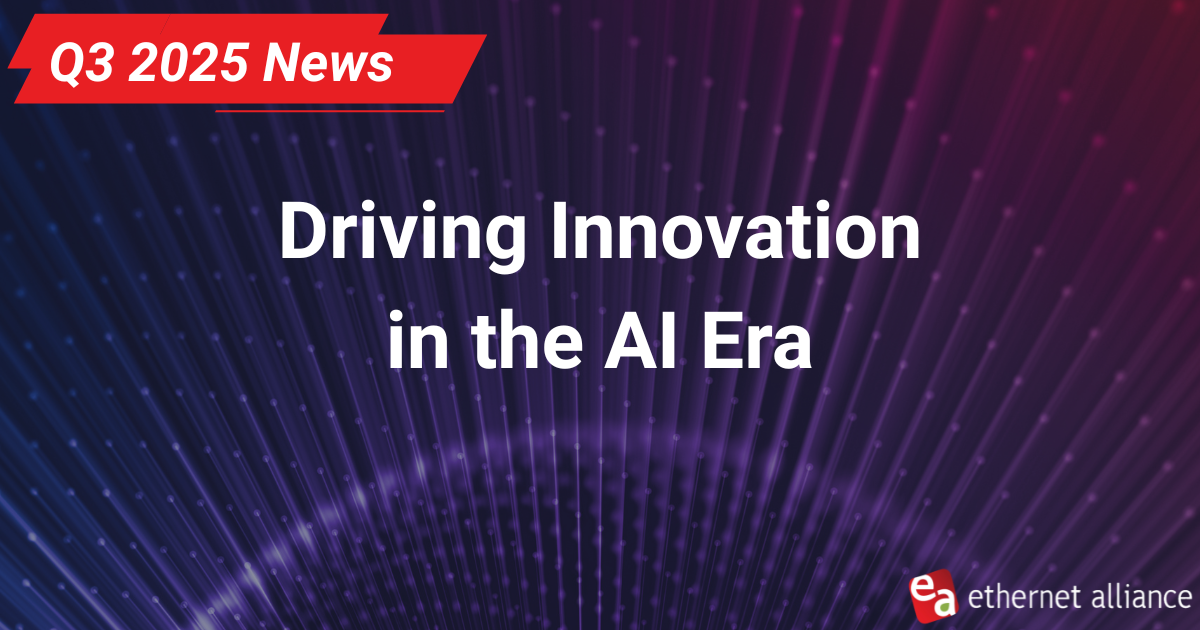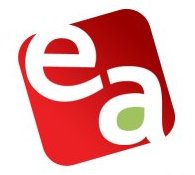Inside the Ethernet Alliance OFC 2025 Demo: Collaboration, Innovation, and Interop

At the heart of every Ethernet Alliance interoperability demo is one guiding principle: show the world Ethernet just works. But these polished demos take months of planning, problem-solving, and technical ingenuity to bring to life, led by a group of dedicated experts. At OFC 2025, Ethernet Alliance Technical Leads Anabel Alarcon of EXFO, Keith Cole of VeEX, and Dave Estes of Spirent were the driving force behind one of the most popular exhibits on the show floor. In this Q&A, they share what it took to pull it off, what excited them the most, and where they see Ethernet heading in the future.
What was your biggest takeaway from this year’s demo?
Anabel Alarcon: For me, two trends stood out. First, liquid cooling made a bold debut. As devices get faster, hotter, and more power-hungry, efficient cooling is becoming mission-critical. Second, we showcased 800ZR interconnects, which represent the next big step for long-distance coherent optics.
Keith Cole: The level of maturity across the 800GE ecosystem was really impressive. Switches, routers, chipsets, traffic generators and analyzers, and pluggables, it all came together seamlessly. It validates that the technology stack is ready for broader deployment.
Dave Estes: The big message? 800G is here. And the Ethernet ecosystem, including linear optics, is ready to scale. The collaboration between vendors made that abundantly clear.
Which part of the demo were you responsible for and what did it showcase?
Anabel Alarcon: I led the 800G/400G testbed, covering a range of interconnects, transceivers, and breakout configurations operating at both 800G and 400G:
- Auto Negotiation and Link Training: We demonstrated a multi-vendor electrical link setup leveraging sophisticated, auto-tuning algorithms to optimize signal quality. It’s a powerful but complex process that is ideal for interoperability testing.
- Linear Pluggable Optics (LPO): LPOs skip digital signal processing (DSP) to save power. They’re still relatively new and can be challenging to deploy, so we highlighted their readiness across real-world use cases and multi-vendor environments.
- Liquid Cooling: Using dielectric liquid immersion, we showed that it’s possible to cool high-speed optics without relying on fans. This is huge for AI-scale thermal loads and future-proofing network design.
Keith Cole: I focused on coherent optical networking, including various 800G to 100G ZR/ZR+ links. This year’s demo featured multiple form factors – QSFP-DD800, QSFP-DD, QSFP28 and CFP2-DCO. And we also had a live coherent link to the OIF booth, multi-vendor coherent interop over a 40km span with EDFAs, and other diverse point-to-point links. It all points to coherent Ethernet being real and deployable.
Dave Estes: My role centered around the interoperability waterfall diagram, a visual snapshot of every interconnect in the demo. It captured just how much was happening across the display as a whole, with full visibility into speeds, technologies, and vendor diversity. It was also a helpful aid for presenting the showcase to visitors, media and analysts. You can download the diagram here.
How did the interoperability demo address the demands of AI?
Anabel Alarcon: Two demonstrations stood out for their relevance to AI infrastructure. The first showcased 800G 2xFR4 transceivers, the workhorses of today’s high-speed networking. Our demo showed their maturity, flexibility, and seamless backward compatibility with 400G systems. That kind of adaptability is key for scaling infrastructure efficiently.
The second featured transceivers operating while submerged in dielectric liquid, a nod to the increasing need for more efficient thermal solutions. Compared to traditional fan-based cooling, this approach can lower transceiver temperatures by 15°C or more. For AI workloads, where energy consumption and thermal performance are top concerns, this kind of cooling could be a game-changer.
Keith Cole: The demo made it clear that the industry is ready for 400G and 800G, pluggable modules, and high-speed switches. We were able to bring exactly what today’s AI data centers need – speed, reliability, and multi-vendor interoperability – to the table.
Dave Estes: The 800G, LPO, ROCEv2, and PFC/ECN demos made a strong case for Ethernet’s role in next-gen AI networks. The LPO demo, for example, showed how we can cut power usage without sacrificing performance. The ROCEv2 and PFC/ECN demos illustrated how different traffic control methods can help manage congestion in AI training clusters.
Why is multi-vendor interoperability critical in today’s networking landscape?
Anabel Alarcon: Interoperability isn’t a nice to have; it’s an absolute must have. One of the biggest challenges in designing and developing new technology is ensuring it interoperates reliably with existing industry standards. Every piece of equipment needs to play well with others, and these demos help uncover integration issues before they reach customers. It’s also an effective means of validating (or challenging!) design assumptions.
Keith Cole: As networks move away from closed, single-vendor solutions, multi-vendor interoperability becomes table stakes. It’s how you ensure complex deployments remain efficient, scalable, and maintainable in the real world.
Dave Estes: When technologies work across vendors, it’s a sign that it’s ready for the real world. That’s why these demos matter.
Any final thoughts on your OFC experience?
Anabel Alarcon: This was my first time as a Technical Lead for Ethernet Alliance’s OFC showcase, and it’s been an incredible experience. Being in the room with some of the industry’s top minds – and having the chance to lead – has been both inspiring and empowering. As a woman in tech, I hope it sends a strong message: women are not just part of the conversation; we’re leading it.
Keith Cole: The VeEX team is deeply involved in multi-vendor interoperability, high-speed testing, and compliance. OFC 2025 gave us the opportunity to align with our industry peers, and continue the important dialogue about what it takes to achieve seamless interoperability.
Dave Estes: OFC is one of the highlights of the year. You get to collaborate with people who you don’t usually get to work with, even competitors, and that’s what makes it such a great experience.

Watch highlights from our OFC 2025 multi-vendor interoperability showcase here.
- 16 Members, 1 Amazing Demo: Inside the Ethernet Alliance Interoperability Showcase at OFC 2025
- Inside the Ethernet Alliance Interoperability Demo at OFC 2025: Making “It Just Works” Work
- Celebrating 10 Years of the Ethernet Roadmap at OFC 2025
- Ethernet Alliance en OFC 2025 en español




